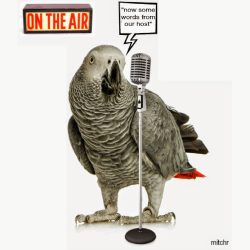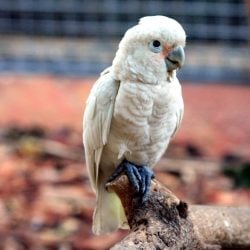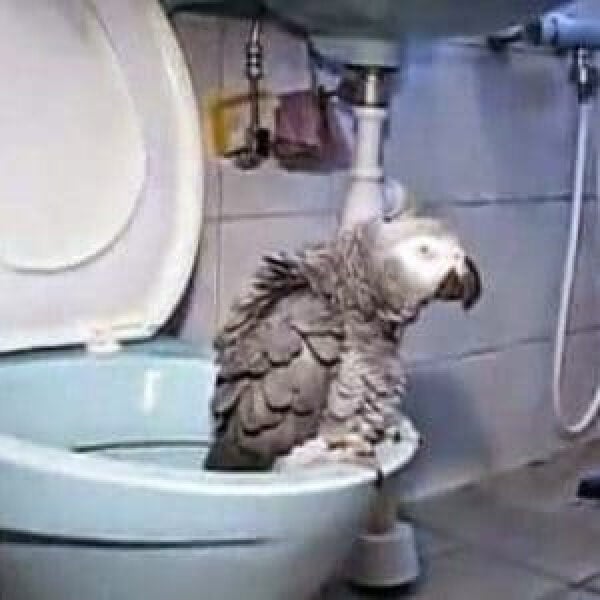Last Updated on by Mitch Rezman
The Eastern Rosella above has very long nails while sitting on an undersized perch. In the not-too-distant future the nails on the front toes can irritate and/or puncture the rear toes causing sores known as “bumblefoot” possibly leading to a foot infection.
From last week’s Birdie Brunch table 19 writes – Hi WCP folks,
I really enjoy the birdie brunch. I have tried to search the archives but can’t figure out how.
I’m wondering what your opinion is on nail clipping for lovebirds. It seems like some people swear that it’s critical, while others suggest it only if they get long.
But how long is too long?
I’ve had my bird for over a year and haven’t clipped her nails.
(She’s about 18 months old.)
They are about 5 mm long, and don’t appear to be getting in her way, or curling all the way around any of her perches, but I’d be happy to do it if it’s the right thing.
Thanks! Talia a Customer
Before Catherine answers, this question now is the perfect time to bring toweling to the discussion. if you going to have a big bird you’ll need to master the art of toweling. Simple tasks like nail trimming will go smoothly if you’re able to restrain your bird in a towel
Small birds can be restrained quite easily as illustrated below. You probably still need a helper because as you’ll find out toenail trimming requires two hands.
For small birds, use your thumb and last two digits to cradle the wings and restrain the head with the second and third digits
Dear Talia
All caged birds may need their nails clipped. The smaller birds have so little weight, they usually grow their nails long as they cannot rely on their weight to help them keep them filed on a pedicure perch.
If your bird’s nails are getting hung up in things, fabric, carpeting, clothes, they should be clipped. If their nails prevent their toes from closing onto a perch well, then they need clipping. If they are starting to curl, they need clipping. A curve is fine but if they are starting to curve beyond a 1/3 of the way around a perch (imagine a circle) then they need clipping.
Yes, get started clipping using the proper nail scissors, just do the very tips to start, it will help you get used to it and ease your tension, you can always clip a bit more.
Be sure to have a styptic product like Morning Bird Natural Blood Stop Powder before you do the nails. If you nick a nail vein you can pack it with the powder or gel and move on to the next nail.
Feathered factoid: in an emergency should you not have any blood-clotting agent in your bird keepers toolkit you can drag the birds nail along the top of a bar of soap. It’s an old caged bird keepers trick.
As time goes by, you will become better at it, clip a bit, look at the nail, you may be able to see inside and if you see space with no vein, then give it a bit more of a clip.
Thank you – Catherine
I’m going to jump in here and advocate a rotary trimmer as a more humane method for birds. it’s much less likely to cause any bleeding because it is far less guessing as to where the quick is. The problem of knowing where the quick is is illustrated below
The rotary trimmer can also be used for many projects and hobbies around your home so it becomes a small but worthwhile investment. With that commercial announcement out of the way let’s come full circle and talk about the implications of a parrot pedicure.
It’s not uncommon for people who keep their bird’s wings clipped, to clip the wings and trim the nails at the same time be it done by a professional or DIY. After a wing clipping and or a nail trimming session you’ll want to watch your bird closely for the next few hours (day or 2 ??), especially in his or her cage.
Birds with trimmed nails may not be able to grip certain perches in the cage easily if they had longer nails. A parrot with clipped wings is a bird with a reduced sense of balance. Don’t allow your bird to injure itself with this perfect storm of reduced grip and a reduced sense of balance. A loud noise or a thunderstorm in the middle of the night could startle your bird causing him or her to easily slip off of perch and fall somewhere in the cage potentially injuring itself – you’ve been warned.
Written by Mitch Rezman & Catherine Tobsing
Author Profile

Latest entries
 Bird & Parrot CareJune 20, 2025Understanding the Best Way to Use Prevue Pets Mimic Me Voice Trainer
Bird & Parrot CareJune 20, 2025Understanding the Best Way to Use Prevue Pets Mimic Me Voice Trainer Bird BehaviorJune 6, 2025How Do I Keep My Parrot From Dumping His Food Every Day?
Bird BehaviorJune 6, 2025How Do I Keep My Parrot From Dumping His Food Every Day? Birds & LightingMay 16, 2025I Am Seeking Clarity About Lighting for My Birds Cage
Birds & LightingMay 16, 2025I Am Seeking Clarity About Lighting for My Birds Cage Bird RescueApril 29, 2025How Do We Re-Home a 17 yr Goffin Cockatoo?
Bird RescueApril 29, 2025How Do We Re-Home a 17 yr Goffin Cockatoo?




